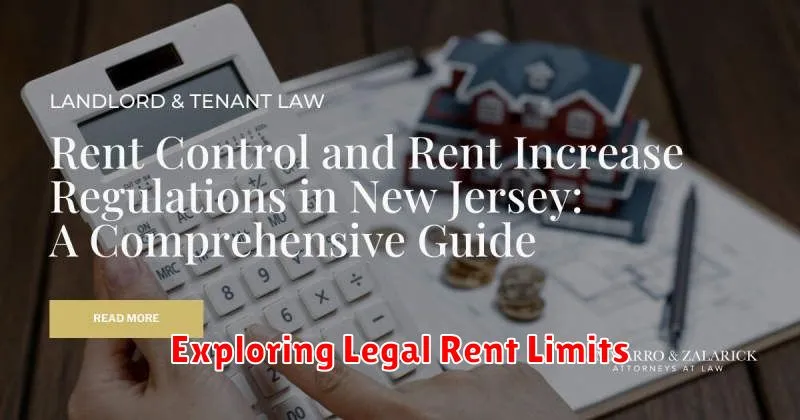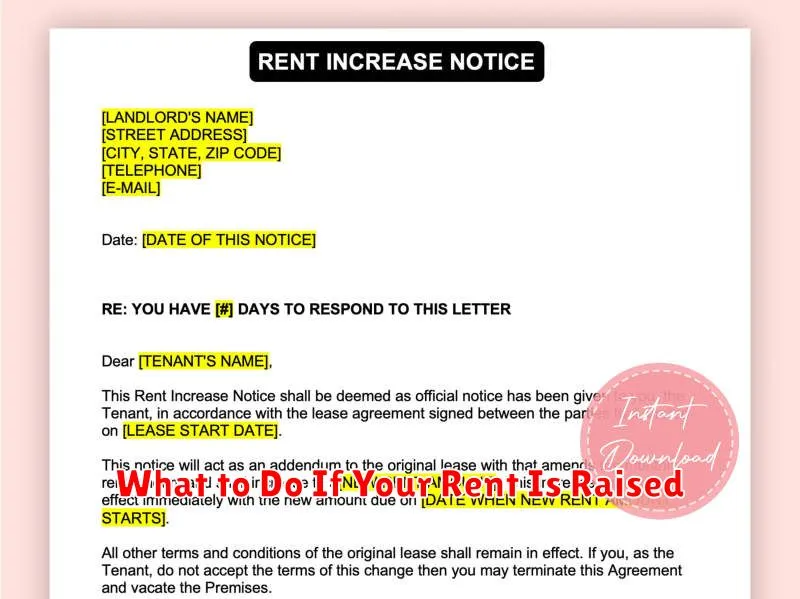Facing a rent increase can be a stressful experience. Whether your landlord has informed you of an upcoming rent hike or you’re simply anticipating one, understanding your rights and options is crucial. This article provides essential guidance on navigating the complexities of a rent increase, outlining the steps you can take to address the situation effectively and protect your financial well-being. From understanding the legality of the rent increase to negotiating with your landlord and exploring alternative housing options, we’ll cover key strategies to help you manage this challenging situation.
Dealing with a higher rent requires careful consideration and a proactive approach. Knowing your rights as a tenant is the first step in navigating a rent increase. This article will explore topics such as reviewing your lease agreement, researching local rent control laws (if applicable), and understanding allowable rent increase limits. We’ll also delve into effective communication strategies for negotiating with your landlord and discuss how to prepare for potential outcomes, including considering alternative housing options if a compromise cannot be reached. Don’t face a rent increase unprepared; empower yourself with the knowledge and tools you need to navigate this situation successfully.
Understanding Why Rent Might Increase
Rent increases can be frustrating, but they’re often a reflection of larger economic trends. Inflation plays a significant role, as rising costs for goods and services impact landlords’ expenses, such as property taxes, maintenance, and insurance. When these costs go up, landlords may raise rent to maintain their profit margins. Additionally, market conditions, like high demand and low vacancy rates, can empower landlords to increase rents. In a competitive rental market, landlords are more likely to charge higher prices if they know units will be quickly filled.
Local regulations can also impact rent increases. Some cities have rent control ordinances that limit how much a landlord can raise rent annually, often tying increases to the cost of living index. However, many areas lack such regulations, leaving landlords more freedom to determine rental rates. Improvements to the property might also justify a rent increase. If a landlord invests in significant upgrades, such as renovating kitchens or bathrooms, adding amenities, or improving security, they may increase rent to reflect the added value.
Finally, your lease agreement is a critical document in understanding potential rent increases. Be sure to carefully review the terms regarding rent increases, including any limitations or notification requirements. Understanding your lease and the factors influencing rent increases will help you be prepared and navigate potential changes effectively.
Your Rights as a Tenant
As a tenant, you have several key rights protected by law. These rights generally ensure safe and habitable living conditions. This includes the right to a habitable dwelling, free from significant defects that impact health and safety, such as a functioning roof, plumbing, and heating. You also have a right to quiet enjoyment of your property, meaning the landlord cannot unreasonably interfere with your use and enjoyment of the rented space. Additionally, you have a right to privacy, and the landlord cannot enter your unit without proper notice, except in emergencies.
Your lease agreement outlines specific terms and conditions of your tenancy, including the amount and due date of rent, the length of the lease, and responsibilities for maintenance. It is essential to read and understand your lease thoroughly. Important lease terms often cover the procedures for repairs, rules regarding pets, and the process for lease renewal or termination. Remember that you have the right to receive a copy of your signed lease.
If your landlord violates your rights or breaches the lease agreement, you have legal recourse. Document any issues or breaches, and attempt to resolve them directly with your landlord first. If direct communication is unsuccessful, consider contacting your local tenant rights organization or seeking legal advice. Remember to familiarize yourself with local and state tenant laws as they can vary.
How to Talk to Your Landlord About It

Communicating effectively with your landlord is crucial for a positive tenant-landlord relationship. Before approaching your landlord, clearly identify the issue and gather any relevant documentation, such as photos, videos, or copies of your lease agreement. This preparation will help you present your case concisely and professionally. Decide on your desired outcome, whether it’s a repair, a rent adjustment, or clarification on a lease term. Having a clear goal in mind will help you stay focused during the conversation.
Choose the appropriate communication method. For non-urgent matters, email or a written letter allows you to document the interaction and provides your landlord with time to consider a response. For urgent issues requiring immediate attention, a phone call or in-person visit might be necessary. When communicating, remain respectful and polite, even if you’re frustrated. Clearly explain the issue, providing specific details and supporting evidence. Listen carefully to your landlord’s perspective and work together to find a mutually agreeable solution.
If your landlord is unresponsive or unwilling to address a legitimate concern, consider reviewing your lease agreement for specific clauses related to the issue. You may also want to consult your local tenant rights organization for guidance on your legal options. Documenting all communication attempts, including dates, times, and methods of contact, is essential should further action be required. Remember, open and honest communication is key to resolving most landlord-tenant issues effectively.
Planning for New Budget Constraints

Budget constraints require careful planning and adjustments to spending habits. It is crucial to assess the current financial situation, identifying both income and expenses. Start by listing all sources of income, then categorize and itemize all expenses. This provides a clear picture of where money is being spent, highlighting areas where reductions can be made. Analyzing spending patterns enables the development of a realistic budget that aligns with the new constraints.
Prioritizing essential expenses is the next step. Needs, such as housing, food, and utilities, should take precedence over discretionary spending like entertainment and dining out. Consider ways to reduce costs within each category. For example, explore options for lowering utility bills by conserving energy, or look for more affordable grocery options. Negotiating lower rates for services, such as internet or insurance, can also contribute to significant savings. Developing a prioritized spending plan ensures that essential needs are met while staying within the new budget limits.
Regular monitoring and adjustments are essential for maintaining a successful budget. Tracking spending allows for quick identification of any deviations from the plan. Periodic reviews of the budget can help identify areas where further adjustments might be necessary due to changing circumstances or unforeseen expenses. This proactive approach ensures that the budget remains relevant and effective in managing financial resources within the new constraints.
Exploring Legal Rent Limits

Rent control, or rent stabilization, refers to government-imposed limitations on the amount landlords can increase rent for residential properties. These regulations aim to protect tenants from exorbitant rent hikes, promoting housing affordability and stability, particularly in areas experiencing rapid economic growth or housing shortages. The specific mechanisms and restrictions of rent control vary widely depending on local laws and regulations. Some jurisdictions implement a complete freeze on rent increases, while others permit annual adjustments tied to inflation or other economic indicators.
The implementation of rent control is a subject of ongoing debate. Proponents argue that it’s crucial for protecting vulnerable populations from displacement and ensuring access to affordable housing. They highlight its potential to stabilize communities and prevent widespread homelessness. Critics, however, contend that rent control can discourage new construction, reduce the quality of existing housing stock, and create artificial housing shortages by discouraging investment in rental properties. They often propose alternative solutions, such as increasing the availability of affordable housing through government subsidies or incentivizing private development.
Understanding the specific rent control laws in your area requires careful research of local ordinances and regulations. Consulting with a legal professional specializing in tenant rights or contacting your local housing authority can provide valuable insights into your rights and responsibilities as a tenant or landlord. Staying informed about changes in local housing policies is crucial for navigating the complexities of the rental market effectively.
Consider Downsizing or Moving
Downsizing or moving can be a significant financial decision, offering potential for substantial savings. Smaller homes typically come with lower property taxes, utility bills, and maintenance costs. Relocating to a less expensive area can also dramatically reduce living expenses, from housing and groceries to transportation and entertainment. Carefully evaluate your current needs and expenses to determine if downsizing or moving could improve your financial well-being.
Before making a decision, thoroughly research potential new locations or smaller housing options. Consider factors such as proximity to family and friends, access to healthcare and amenities, and the overall cost of living in the new area. For downsizing, assess your belongings and determine what you truly need versus what can be sold, donated, or discarded. This process can be challenging, but it’s crucial for a successful transition.
Finally, create a realistic budget that incorporates all the costs associated with downsizing or moving. Include expenses like moving fees, closing costs (if applicable), and any potential renovations or updates needed in a new home. By planning carefully and weighing the potential benefits against the costs involved, you can make an informed decision about whether downsizing or moving is the right choice for your financial future.
How to Negotiate or File a Dispute
Negotiating a dispute often involves direct communication with the other party. Clearly state your desired outcome and the reasons behind it. Listen actively to the other party’s perspective and look for mutually agreeable solutions. Be prepared to compromise to reach a resolution. If direct negotiation fails, consider mediation where a neutral third party helps facilitate communication and find common ground.
If negotiation and mediation prove unsuccessful, filing a formal dispute may be necessary. This process typically involves submitting a written complaint or claim outlining the issue, relevant facts, supporting documentation, and your desired resolution. Understand the specific procedures and deadlines associated with filing the dispute, which can vary depending on the nature of the issue and the governing body or institution. This may involve filing with a court, regulatory agency, or designated dispute resolution organization.
Throughout the entire process, it’s crucial to keep detailed records of all communication, agreements, and actions taken. This documentation will be valuable in supporting your case if the dispute escalates to formal proceedings. Consult with an attorney or advisor if needed to ensure you are taking the appropriate steps and protecting your rights.

